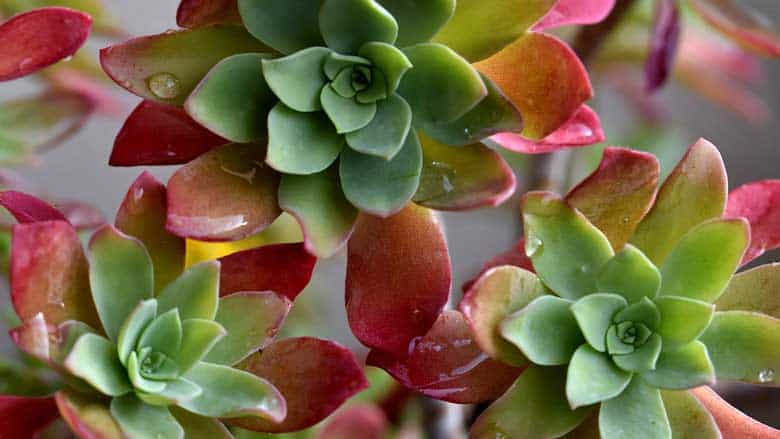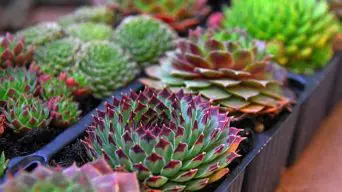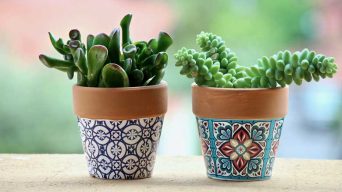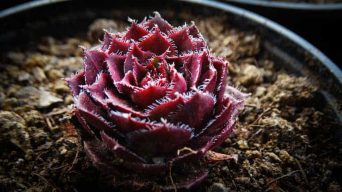Water succulents every 1 to 2 weeks when the soil is dry, adjusting based on weather and season. In colder months, reduce frequency to once every 3 to 4 weeks. The key is allowing the soil to dry completely between waterings.
The succulent plant is the latest trend in home decor. They are trendy, easy to care for, and look good anywhere.
While they might be simple to maintain, you still need to know some important things about watering them correctly.
Watering succulents is one of the primary concerns for new gardeners.
Everyone wants to make sure that their plants are thriving and healthy, but when it comes down to actually caring for your succulent, there’s a lot you need to know before beginning.
In this article, we will discuss how often should you water a succulent plant so you can keep yours healthy and vibrant.
How Often Do You Water Succulent Plants
Succulents are easy to grow and maintain.
In general, succulent plants require less watering than other types of houseplants because they store moisture in their leaves for periods without rainfall or irrigation.
The frequency and amount of water a succulent requires depends on several factors, including the size and type of pot it’s in, how quickly moisture drains from the soil, the temperature and humidity of the environment, and the time of year.
Succulents native to arid regions and those found in dry climates, such as cactus plants, require less watering than succulents from wetter climates, such as Sempervivum (common houseplants that are often called Hens and Chicks).
In general, however, most types of succulent plants need water about once a week during the growing season or twice a month if the plant is in a humid environment.
Succulents should be watered until excess moisture drains from the bottom of their pots, or they can develop root rot.
The best way to tell if a succulent needs water is to feel the soil. If the potting mix feels dry, it’s time for watering.
A good rule of thumb is that most plants need about an inch (25 mm) of rain or irrigation every week, though this may vary depending on where you live and how much sun your plant gets.
Watering Summer Growing Succulents
Succulents need more water during the summer months.
During this time, they are actively growing, and their roots are developing in length rather than girth. They can store water in their leaves and stems, but they also need to drink more.
They need to be watered more frequently when it’s hot outside (especially during the afternoons).
Around one to two times per week should be sufficient.
If you live in a very hot climate, it might even be necessary to water succulents up to three times per week during the height of summertime weather.
Soak their soil well and let it dry out between watering cycles. Remember that they can store moisture, so sometimes, it isn’t necessary to water them as frequently as you might think.
It’s always a good idea to check the soil mix before watering anyway, because it can be easy to overwater succulents and drown their roots if they are sitting in wet, soggy soil all of the time.
To avoid overwatering succulents and drowning their roots, make sure the pot they are in has a drainage hole at the bottom to allow excess water to escape, and never let the soil become soggy.
If this does happen, make sure that you let things dry out and then water sparingly until the soil is completely dry before watering again.
Watering Winter Growing Succulents
During the winter months, when the temperatures are lower and the days are shorter, succulent plants need less water.
Most succulents will go into a state of dormancy and will not need as much water during this time.
It is best to give succulents about half of the amount of water they usually need. Usually, this is once every two weeks, but it may only be once a month during the winter.
If you are unsure how often to water succulents, err on the side of watering less because overwatering can cause root rot and kill plants quickly.
If you live in a hotter climate, it is important to keep your succulents hydrated during the winter.
For those in very hot climates or regions with little rainfall, you should water succulent plants as usual at this time of year.
It can be hard for these plants to absorb enough moisture from dry air if they are not watered frequently enough, so make sure their soil stays moist all winter long unless there is an unusual cold spell.
If you live somewhere colder where watering usually isn’t necessary until later on in the season, then around February, give your succulent about half of the usual amount of water and monitor their soil carefully after that point.
If it starts getting warmer outside and rain returns to your area, you should water your plants as usual.
If you are growing succulents indoors, then watering them should only be necessary every other week during the winter months.
This is especially true if there isn’t much natural sunlight in that area or window of your home.
You can check to see how moist their soil feels before checking the calendar and deciding when it’s time for a good soak-your finger will tell you whether they need more water!
How Often Should You Water Indoor Succulents
Growing succulents indoors can be a life-changing experience because they are so easy to take care of.
But one thing people might not know is how often to water succulents. Succulents have specific needs that need to be taken into consideration when caring for these plants.
If your succulent is in a place with low light, you will want to water it less often. They are very drought-tolerant plants and thrive in periods of no watering.
However, if your plant has medium or high lighting, it should be watered more frequently because the sun quickly dries out its roots.
Usually, succulents should be watered every week or every other week.
Check the moisture levels of your plant by feeling its potting soil and see if it is moist throughout to determine what you need to do next.
This will help prevent overwatering, which can rot out a succulent quickly, leading to its demise. However, keeping them dry for too long can also kill off these plants.
So when in doubt about how often you should water succulents indoors, water once per month, but make sure the soil feels like a wrung-out sponge and let air through (the key here is not drowning the roots).
This means watering less frequently than weekly for most people since our homes are very humid compared to outside conditions.
If you water succulents once weekly and the soil stays moist, you’re watering too much.
Watering succulents more than weekly can lead to root rot or mold issues, so don’t overwater!
How Often Should You Water an Outdoor Succulent
The watering frequency of outdoor succulents depends on your climate.
If you live in an area with high humidity, when caring for outdoor succulents, you need to water them once every other week, which should be enough. In climates with hardly any humidity, succulents must be watered more often.
When you live in a dry area, you might want to consider growing succulents in a pot. That way, the water will stay contained and won’t evaporate as quickly.
Using containers designed explicitly for succulents, you can ensure that the water is contained and won’t evaporate as quickly, allowing your succulents to thrive in their pot environment.
If your outdoor succulent is planted in the ground, it’s essential to check the soil for moisture before you water. If it feels moist at a depth of one inch, your plant doesn’t need watering yet!
However, if the top two inches are dry, then go ahead and give them some water. A good rule of thumb is to wait until the surface starts cracking before watering.
The most important thing is that the soil dries out between waterings, which you can tell with your finger by pushing it down into the soil.
If it’s dry below about an inch of depth, it’s time to water again!
The location of the soil in your garden can be a significant factor in determining when to water, as the soil in sunnier, warmer locations may dry out more quickly than soil in shadier, cooler spots, so be sure to check the moisture level of the soil at least an inch deep in any given area before deciding when to water.
How Do You Know When a Succulent Needs To Be Watered
As with many plants, succulents will tell you when they need to be watered. However, it can often be difficult for beginners to identify some of these signs and symptoms.
One of the easiest ways to tell if a succulent needs water is by checking its soil. If it feels dry or compacted, add some fresh water and allow it to drain out through the bottom of the pot before adding more.
Another thing that can help determine whether a succulent plant needs watering is checking for signs of overwatering and underwatering. This can help you to understand how often you should water your succulents.
What Does an Overwatered Succulent Looks Like
The soil will look soggy when you overwater a succulent, and the plant’s leaves or stems may begin to rot.
This is a sign that you should stop watering and allow the soil to dry out for several days before adding more water.
If your succulent has been overwatered, there are likely signs of root rot around its stem base and lower leaf bases, which appear as red-brown zones on the leaves close to where they meet the roots.
Another thing to watch out for with an overwatered succulent is slime mold growing near or inside due to excess moisture in its environment.
If you notice these signs, your succulent needs to be repotted and the soil replaced.
You will need to cut away dead tissue and remove rotted roots before replanting it in soil that drains well.
Once the dead tissue and rotted roots have been removed, the replanted plant should be placed in a pot with a drain hole at the bottom to allow excess water to escape, thus preventing the soil from becoming waterlogged and allowing the plant to thrive.
Also, in order to ensure that the soil does not become waterlogged, it is important to mix sand and pumice into the soil, as this will act as a drainage system, allowing excess water to drain away while still providing the plant with the necessary nutrients it needs to thrive.
After you have made the necessary changes, you will need to allow your succulent plant to dry out for a few days or weeks until its leaves begin to wilt on their own due to lack of water.
At this point, give it very little water at all so that the soil is just barely moist.
Over time, your succulent’s root system will recover from being overwatered. Once enough time without watering has been allowed, you can resume regular watering as always with a newly-repotted succulent.
What Does an Underwatered Succulent Looks Like
If you don’t water your succulents enough, they can become wilted, and their leaves will wrinkle up.
If these symptoms persist over several days, they indicate that the succulent is not receiving enough water.
The plant may also cease to grow altogether if this issue is not resolved promptly.
However, some signs indicate underwatering rather than overwatering, such as dryness around the roots and yellowish leaves.
If you notice these symptoms, it is likely that your succulent needs more water and less sun.
Water underwatered succulents thoroughly until water flows out of the drainage holes at the bottom of the pot.
After watering, allow the soil to dry out for several days before watering again.
If you have been underwatering your succulent for some time, it is best to gradually increase its watering schedule rather than suddenly giving it a lot of water all at once, as this can lead to root rot.
It may also be helpful to increase humidity around the plant and ensure its pot has drainage holes.
If your succulent has been underwatered, you will need to place it in a shallow tray of water and wait for about twenty minutes.
After this period is over, remove the plant from its tray and allow it to dry out well before watering again.
However, if you find that your succulents have been underwatered for a long time, they may need to be repotted and their soil replaced.
It is also possible that the drainage holes in your succulent pot are clogged with dirt or gravel, which can prevent water from draining correctly through them.
If this is the case, you will need to clean out the holes and replace any damaged or rotted roots.
While repotting, it is also possible to add new soil with better drainage properties to help your succulents grow more quickly than before.
After all of these changes have been made, you should see a marked improvement in your plant’s health within several days or weeks.
How Long Can a Succulent Go Without Water
Succulents are very drought-tolerant, and they need less water than other types of plants.
How long a succulent can go without water depends on the species and growing conditions.
Most succulents can go a few weeks without water, but some species of cacti can go a month or more without water.
Usually, succulents with compact and thick stems and leaves can go longer without water. The plants store the water in their leaves, stems, and roots (if they are thick enough).
Succulents with thin leaves don’t store as much water and need more frequent watering.
On the other hand, indoor succulents need less water than outdoor plants. Some succulents can go a month or more without water, while others require regular watering every week.
How Much Water Do Succulents Need
Succulents do not need a lot of water.
Succulent plants are grown in areas with low rainfall and drought conditions, so they have adapted to survive under these conditions by storing all the extra moisture within their leaves or stems for later use.
Therefore, succulents can go for long periods without needing water while also holding large amounts of it when needed.
Because of this, you will want to make sure that your green friend has enough access to water but, at the same time, is not drowning in it either!
However, there is a fine line between not providing enough water and overwatering.
In the wild, their natural habitats are arid areas with infrequent rain, but it can be heavy and long-lasting when it does rain.
For this reason, when watering succulents, you should only water them when the soil is completely dry.
When you water your succulents, make sure that you thoroughly soak their soil until it begin to drain out of any holes in the bottom of the pot or container.
How Do You Water Succulents
There are many different types of succulent plants, but they all share certain commonalities.
For example, most people assume you should water them at least once a week because the soil gets dry.
The truth is that it depends on how much heat and sunlight your particular plant receives to determine when or if it needs watering. It might even need less water than you think.
Well-draining soil is essential for the health of any succulent plant, regardless of how frequently it needs to be watered or if it’s native to dry, arid climates or not.
So you need to ensure any potting soil is well-draining and will not stay wet for days at a time. You also want to be sure that the drainage holes in your pots are big enough so water doesn’t pool but drains effectively.
Usually, the best time to water your plant is in the morning, but this may vary depending on where you keep your succulent.
If it stays too wet and cold at night, don’t water it until after midday because it will help prevent rot and fungus from getting a foothold in its roots.
Using a watering can with a long spout and a fine-holed rose head to evenly distribute water at the base of the plant, rather than from the top down, is an effective way to prevent crown rot and ensure the long-term health of your plant.
You want to water your succulent plant thoroughly, but you don’t want to saturate the soil. If it is in a pot, water each section until some of that liquid drips out through the drainage holes on the bottom.
It is never recommended to use a spray bottle to mist succulents. These plants are well adapted to dry climates, and they don’t do well in humid conditions.
If you mist them, it will increase the humidity around the succulent leaves and cause fungus damage which can be fatal for your plant if left untreated.
Final Thoughts
Gardening is an art form, and when it comes to succulents, it requires patience, attention to detail, and a keen eye for knowing when and how often to water them in order to ensure they thrive in their environment without becoming over- or under-watered.
It’s also important to consider that each species has different needs, so ensure you follow the proper succulent care guidelines for yours!
Your specific conditions will also dictate the frequency of water needed, but as a general rule, you should check your plants at least once per week.
Water your succulents when the soil is dry, and give them a good soak until water runs out of the drainage holes.
Not letting your succulents sit in water is essential, so ensure you empty any saucers or trays after watering.
Be patient when starting to care for succulents, as it may take some time to get into a watering routine that works for you and your plants.
Once you have established a watering routine that works for you and your plants, you can expect to see healthy growth in your plants over time as they receive the proper amount of water to support their development.
With a little trial and error, you’ll be a succulent pro in no time!







